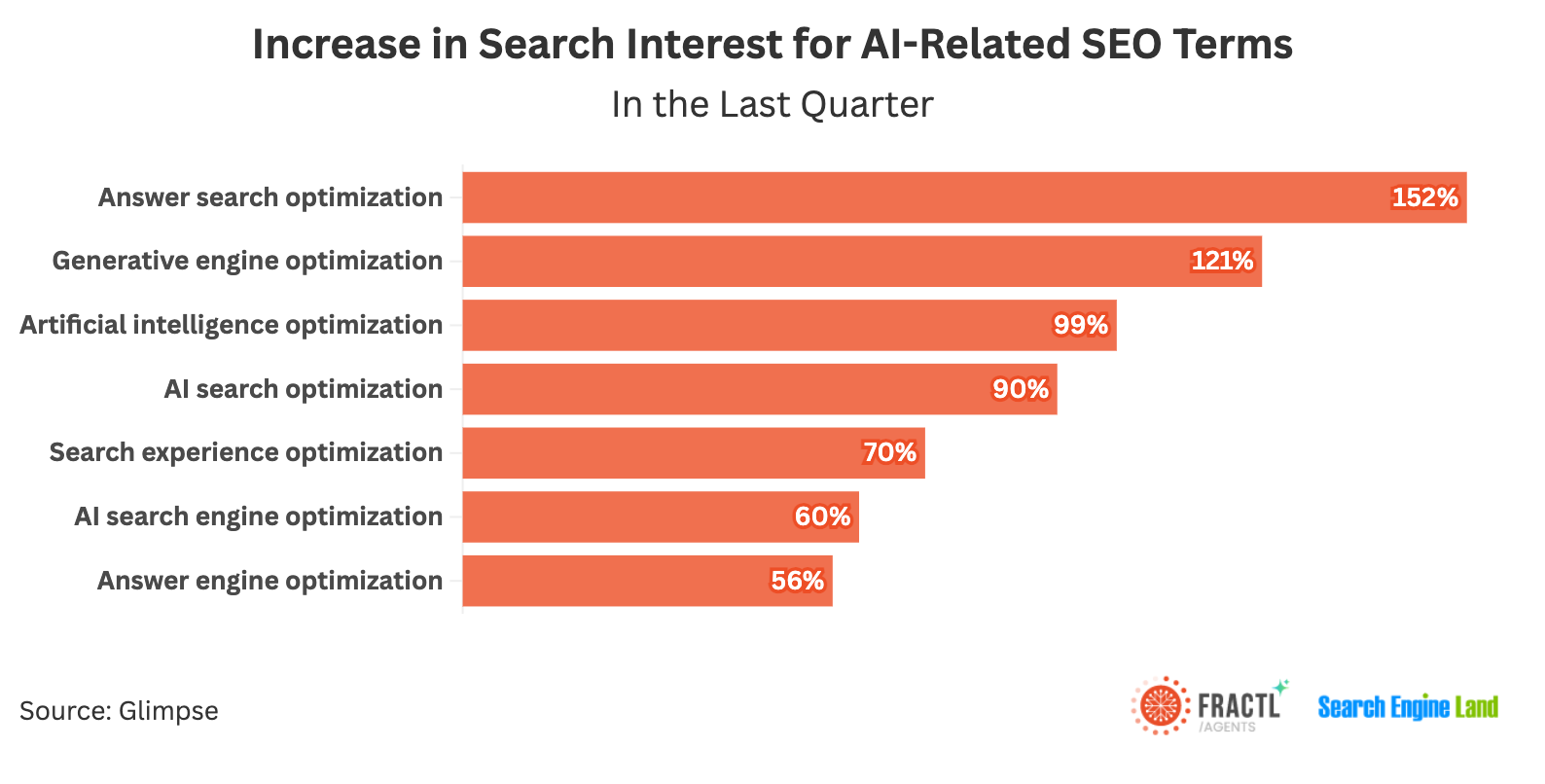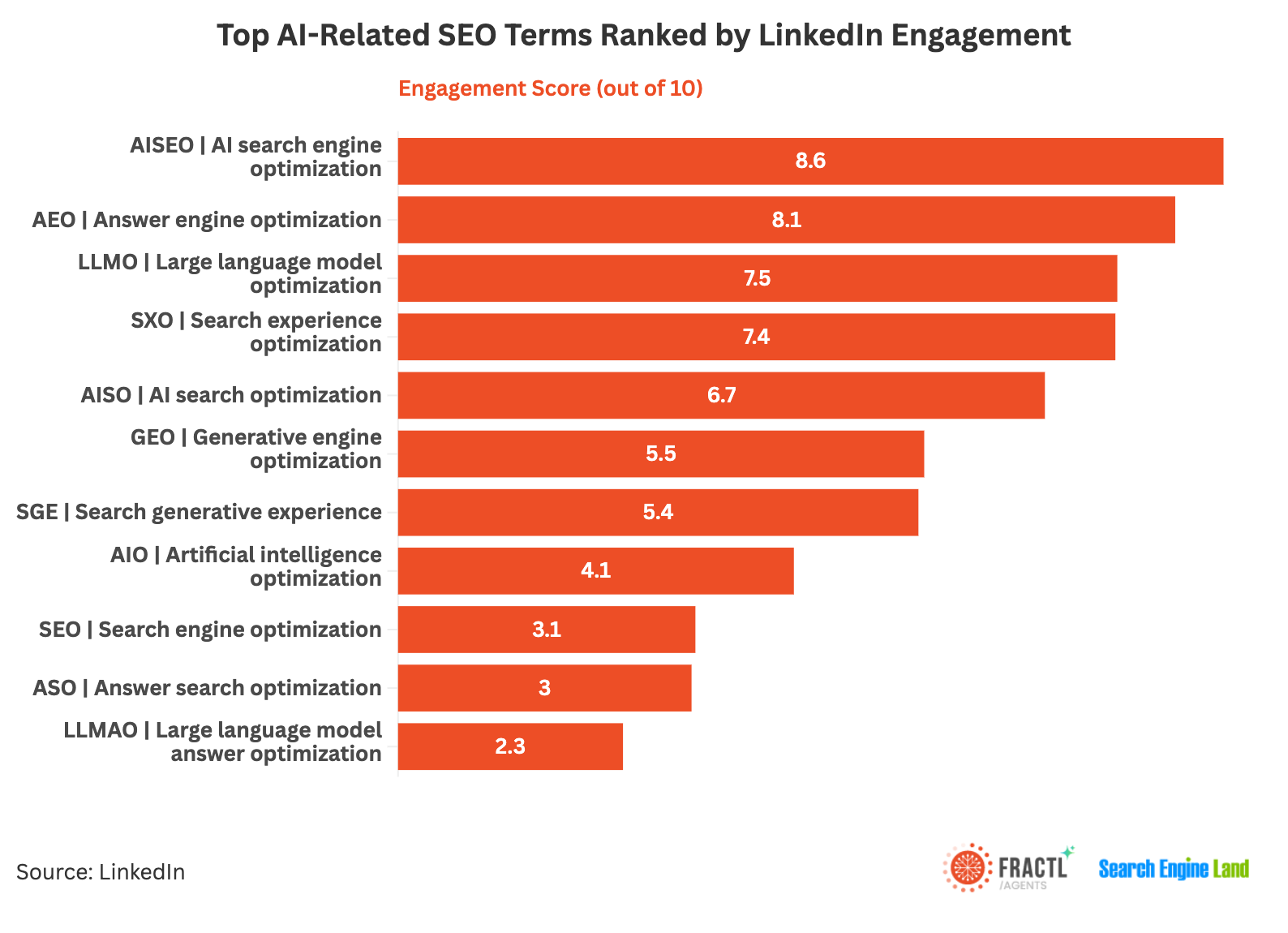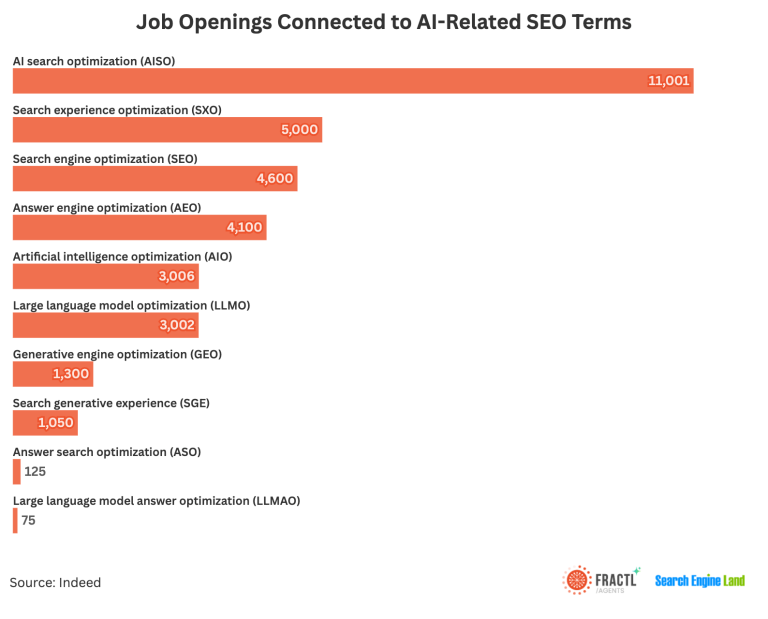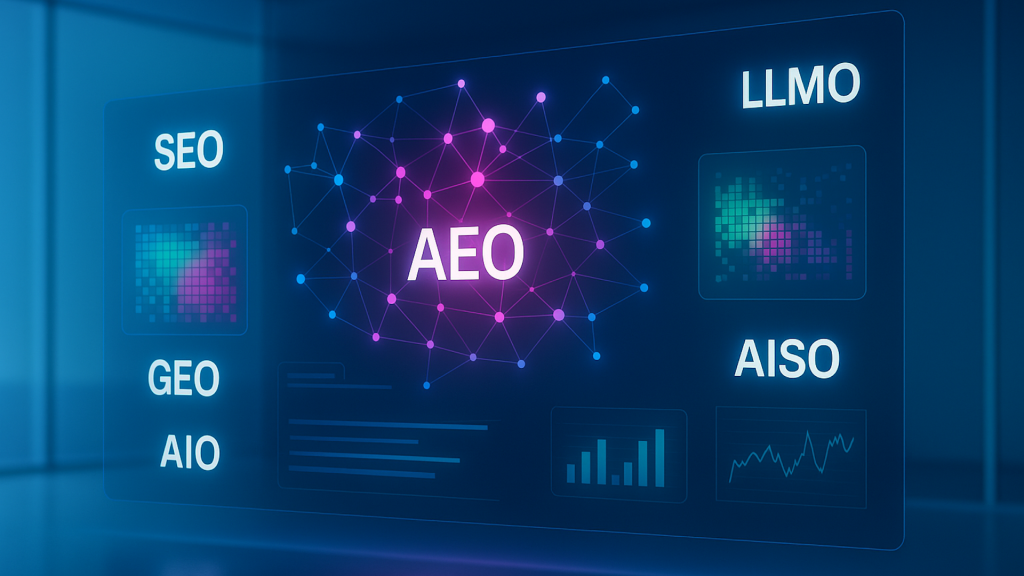SEO, GEO, or ASO? What to call the new era of brand visibility in AI [Research]
![SEO, GEO, or ASO? What to call the new era of brand visibility in AI [Research]](https://seoauthority.com.au/wp-content/uploads/2025/11/SEO-GEO-or-ASO-What-to-call-the-new-era-of-brand-visibility-in-AI-Research.png)
In June, Fractl and Search Engine Land surveyed 2,000 consumers and uncovered a startling statistic: 82% find AI-powered search more helpful than traditional search.
While the SEO industry panicked, thought leaders and snakeoil salesmen took to LinkedIn to lay claim to this new frontier of AI-driven brand visibility:
“It’s called GEO!”
“No, it’s AEO!”
“Oh, we use AISO! Wait, I meant LLMO now!”
…Or, maybe, it’s just effective SEO?
Industry banter aside, we’ve entered a world where old-school search and AI-driven discovery coexist – and the terminology isn’t trivial.
It’s the roadmap for how brands show up across fast-growing search platforms like ChatGPT, which is forecast to hit 1 billion users by year’s end.
To bring clarity to that shifting vocabulary, Fractl partnered with Search Engine Land to map the language of this AI-search era.
Over the past few weeks, we surveyed marketers, scraped thousands of social conversations, and analyzed job boards to understand which terms are actually gaining traction.
The goal was simple: cut through the noise and uncover the labels shaping hiring, strategy, and brand visibility in the age of AI.
TL;DR: Marketers aren’t replacing SEO. They’re stacking new labels on it.
- GEO explains the shift.
- AEO and AISO describe the execution.
- SEO remains the connective tissue that makes it legible across the business.
And that pattern shows up everywhere, from what people Google to what hiring managers post on Indeed.
Let’s drill into the findings.
1. The industry baseline: Third Door Media subscriber survey
While large datasets are essential in studies like this, it’s equally important to fine-tune the analysis by consulting practitioners who actively follow industry news and are directly involved in the work.
To do that, we surveyed Third Door Media subscribers on two simple questions:
- Which AI-related SEO terms do you recognize?
- Which one do you personally use to describe optimizing brand visibility across generative AI platforms?
Right away, it became clear that some terms were far more widely recognized than others:
- 84% recognize generative engine optimization (GEO).
- 61% recognize answer engine optimization (AEO).
- 60% recognize artificial intelligence search engine optimization (AISEO).
Everything else slid straight into niche-term purgatory, with fewer than half of respondents recognizing them. That includes:
- Artificial intelligence optimization (AIO).
- Large language model optimization (LLMO).
- Search experience optimization (SXO).
- Large language model answer optimization (LLMAO).
- Artificial intelligence search optimization (AISO).

Now, usage tells the real story.
When respondents were forced to pick the one term they used to describe optimizing brand visibility across generative AI platforms, we found:
- 42% choose GEO.
- 16% choose AISEO.
- 14% choose SEO or AEO.

This contrast reveals a deeper tension.
Seasoned SEOs overwhelmingly agree that effective SEO strategies fuel AI-driven brand visibility – and 84% of marketers we surveyed recognize GEO.
However, only 14% actually use SEO to describe the work they’re doing to show up across chatbots like ChatGPT and Gemini.
To put this tension in context, Danny Goodwin, Editorial Director of Search Engine Land and SMX, told me:
- “The AI era of search arrived suddenly, and the industry’s identity still hasn’t caught up. We’re in a transitional moment. GEO has emerged as the label of choice in the evolving AI search paradigm. And we are living through a historic, fundamental shift in how people get answers via generative AI and AI assistants.
- “The work of SEO may be (mostly) unchanged – but let’s remember there is not 100% overlap between what worked for SEO and what works for GEO. In the meantime, SEO remains as important as ever – organic search (though it is declining for many as a performance channel) still drives significantly more traffic than AI.”
If you haven’t watched it yet, I also highly recommend Lily Ray’s MozCon talk, “GEO, AEO, LLMO: Separating Fact from Fiction & How to Win in AI Search,” in which she artistically narrates how:
- “GEO finally realizes something important: he’s not here to replace the SEO family, he’s just the newest evolution. Mother SEO reminds him how special he is: ‘You help the world discover answers in brand-new ways, through conversations, multimodal searches, personalized results, paths we never had before.’”
The need for pieces like Ray’s and this article underscores a bigger story than emerging industry nomenclature.
It signals a paradigm fracture, an industry craving new frameworks to define AI-era discovery.
Dig deeper: The origins of SEO and what they mean for GEO and AIO
2. Google Search trends show which AI-era visibility terms are rising fast
Instead of examining raw search volume in Google Trends, we measured the quarter-over-quarter acceleration of searches to identify which terms are gaining traction as we close out 2025.

What emerged is clear: marketers aren’t searching for abstract AI jargon.
They’re looking for language that maps directly to execution.
Each acronym carries a “job to be done,” and the surge patterns reveal how teams are framing their AI-era visibility strategies.
- Answer search optimization (ASO) is the breakout star, surging 152%.
- That spike tells us practitioners are hungry for a label that ties directly to answer experiences.
- Just be sure to spell it out early, since “ASO” is still heavily associated with app store optimization, and nothing derails credibility like acronym whiplash.
- GEO follows closely at 121%, signaling that generative-led discovery is widely recognized (by 84% according to our survey), and it’s continuing to gain traction outside of the SEO sphere.
- AIO is up 99%, acting as a flexible umbrella for teams exploring AI-driven operations efficiencies through agentic workflows. Think of it as the catch-all container for broader AI ops.
- AISO climbed 90%, mirroring what we’re seeing in hiring language: teams want terminology that combines “AI + Search + Optimization” into something more intuitive.
- SXO rose 70%, providing a seamless fit for UX-first discovery strategies that span the SERPs and on-site experiences.
- AISEO grew 60%, another indicator of teams leaning toward longer, more literal terminology to ensure cross-functional clarity.
- AEO grew 56%, a slower quarter relative to the breakout terms, but still a top contender according to our industry survey.
While new labels spark plenty of debate, our survey and trending search data point to two clear standouts: ASO and GEO.
Their traction may stem from their distinct use cases, with GEO aligning more with generative AI chatbots like ChatGPT, and AEO anchoring conversations around AI Overviews-style summaries.
Meanwhile, the rapid rise of AIO and AISO indicates that the industry is converging on a language that blends AI, search, and optimization into something more intuitive for non-SEO stakeholders.
Get the newsletter search marketers rely on.
See terms.
3. The most ‘loved’ term isn’t the most ‘engaging’ term, according to social data
If Google Trends shows curiosity, LinkedIn shows culture.
It’s where new terminology gets battle-tested, memed, debated, misunderstood, and occasionally adopted.
To determine which labels exhibit actual affinity, we analyzed 6,400 LinkedIn posts from August to October.
While GEO still leads in awareness (84%), usage (42%), and quarter-over-quarter search interest (up 121%), the terms with the strongest positive sentiment are surprisingly literal:
- SEO remains the emotional benchmark on LinkedIn, with 90.4% of posts having a positive sentiment score, compared to 85.0% on Reddit.
- AISEO edges out everyone on Reddit with a 95.8% positive sentiment rate, while still earning a very strong 84.8% positive on LinkedIn.

Generative AI platforms may be reshaping how consumers search, but socially, the concepts that resonate most are still “SEO” and “SEO with AI baked in.”
Practitioners aren’t falling in love with clever acronyms.
They’re rewarding labels that clearly signal continuity with the best practices of the discipline they already understand.
This reinforces the growing belief that digital marketers view AI search as an evolution of SEO, rather than a replacement for it.
Then there’s AISO, which plays an interesting middle role – enjoying 90.9% positive sentiment on LinkedIn, but only 46.8% on Reddit.
This suggests that while B2B professionals are receptive to it, wider communities are more skeptical or fragmented in their use of it.
When we shift from sentiment to actual engagement, the hierarchy changes again.
On LinkedIn, the terms that travel the farthest aren’t necessarily the most beloved – they’re the most skimmable, literal, and “post-friendly.”
AISEO sits at the top of the engagement leaderboard with an 8.6 out of 10 score, followed closely by AEO, LLMO, and SXO.
These terms behave like reach accelerators.
They spark fast reactions and shares, making them ideal for headlines, announcements, and POV posts designed to earn surface-level visibility.
Meanwhile, AEO consistently drives deeper comment threads once a post is in the feed, and AISO pulls in hands-on practitioners providing tactical breakdowns more than splashy hooks.
Classic SEO ranks lower in raw engagement, but regains momentum when explicitly framed as “SEO with AI” or linked to templates, workflows, or examples.

Naturally, hot-button acronyms tend to over-index in engagement, while evergreen terms like SEO remain steady.
Sentiment alone isn’t a verdict, but it is a useful read on cultural comfort.
Use this chart directionally and weigh it alongside the fuller patterns we observed across search interest, usage, and hiring language.
If there’s one takeaway from the social side of the research, it’s this: SEO is still the industry’s north star, but AI SEO is emerging as the clean, “no-translation-needed” bridge between classic SEO and AI-driven discovery.
Dig deeper: AI search optimization? GEO? SEOs don’t agree on a name: Survey
4. The labor market: What hiring managers are posting on Indeed
For the most expansive part of our study, we analyzed 33,250 U.S. job postings on Indeed, with both short-form and long-form variants of each term.
And when you look at job postings – not LinkedIn echo chambers nor Reddit hot takes – the future of the SEO industry nomenclature snaps into focus.
Hiring managers aren’t chasing the acronym of the month. They’re defaulting to the one label that captures the full scope of AI-era discovery: AISO.
With 11,001 active postings on Indeed, AISO now outpaces SEO, AEO, GEO, and LLMO combined.
In other words, the labor market has already decided what this era is called.

Goodwin sees this shift as both familiar and new:
- “AISO is a rebrand of classic SEO skills. Companies still want people who understand content, technical fundamentals, UX, and how to be findable when people search. Nothing about that work has suddenly changed.”
- “But the job is also evolving – just as it has at various points over the past 30 years to adapt to new realities (think: algorithm updates or SERP changes) or technological advancements (think: mobile).”
- “Now, you need to work with AI tools and understand how answers are generated. Optimizing for retrieval/inclusion in AI answers is not exactly the same as optimizing for ranking in traditional search.”
Three things marketing leaders should internalize immediately:
- AISO is the market-ready label: It’s broad, intuitive, and now the most widely used term in job listings.
- SEO remains the core headcount: Companies still hire SEO roles at scale. They’re simply layering AI capabilities on top.
- GEO is a strategy, not a job: Use it for thought leadership and training, not talent search. Candidates aren’t looking for “GEO managers,” at least yet.
Hiring managers aren’t looking for specialists in one micro-framework.
They want people who understand how to optimize discovery across human searchers, machine summaries, AI assistants, and knowledge graphs.
If you want applicants to find your job listing, title the role AISO or SEO (AI emphasis), describe the responsibilities using AEO/SXO, and save GEO for internal enablement and external education.
So, what should teams actually do with all this?
The SEO industry glossary is evolving because consumer search itself has splintered across SERPs, chatbots, and social platforms.
But the fundamentals of building an effective inbound marketing strategy haven’t changed, and the SEO job market is expanding.
- SEO isn’t dead.
- GEO isn’t hype.
- AISO isn’t optional.
The good news is, you don’t need to pick a single acronym. You need a framework.
- Use SEO to align teams, budgets, and cross-functional expectations.
- Use GEO to explain the broader shift toward generative discovery.
- Use AEO/AISO to operationalize how content gets surfaced in answers and summaries.
These terms aren’t replacements for SEO.
They’re scaffolding for the same work that has always driven visibility:
- Creating valuable, educational content.
- Distributing it across the channels where your audience actually spends time.
That’s what builds entity strength, brand mentions, and topical authority – the signals every search system, whether driven by ranking algorithms or semantic knowledge graphs, relies on.
As Goodwin put it:
- “We’re not aligned on the terminology within our industry, which is both perfectly acceptable and completely normal in a situation like this. Don’t call it confusion – call it evolution. It may be frustrating because you can’t control what the collective eventually calls this emerging marketing practice.
- “Staying aligned, to me, seems fairly simple: Decide on what you call it, clearly define it in plain English, and stick to it consistently. Avoid explaining it in ‘SEO+’ terms or as a rebrand of the same old SEO playbook. Instead, call it what it actually is: a new mode of discovery with different surfaces, expectations, opportunities, and outcomes.”
Consistently build on these effective strategies, and your brand becomes discoverable everywhere – in AI Overviews, across LLM outputs, in search results, and throughout the social feeds and communities that shape awareness, engagement, and demand.
Methodology
- We surveyed 342 Third Door Media readers about the AI-related SEO terms they know and use, analyzed Google Trends data via Glimpse to measure rising search interest, and reviewed job demand on Indeed across more than 33,250 U.S. postings.
- To gauge real-time industry sentiment, we scraped over 6,400 LinkedIn posts and 3,350 Reddit threads from August to October 2025, analyzing both long-form and abbreviated versions of emerging terms using the VADER sentiment model.
- Taken together, these inputs reveal which labels marketers are actually adopting, and which ones are resonating in the broader conversation about brand visibility in the age of generative AI.







Recent Comments